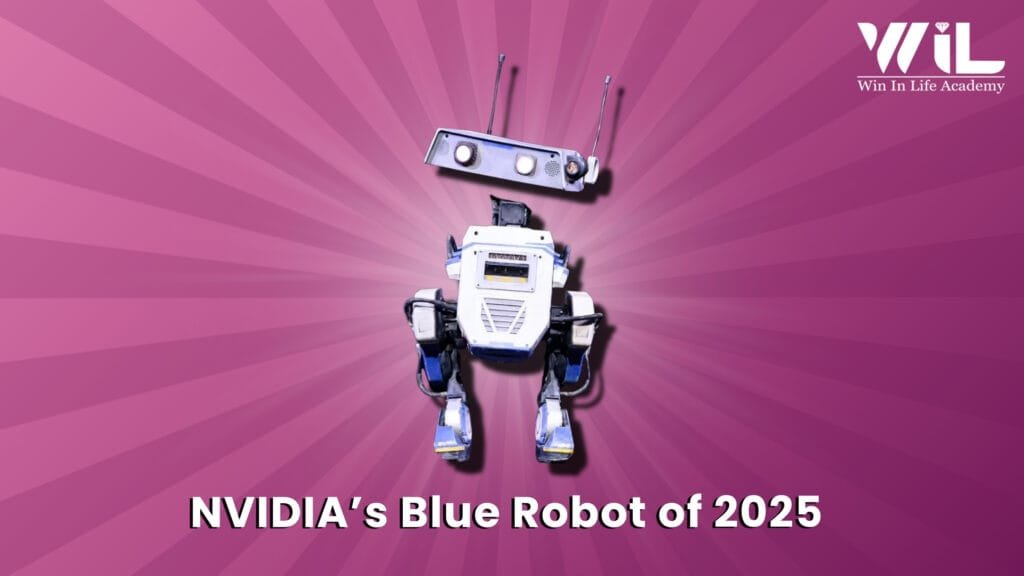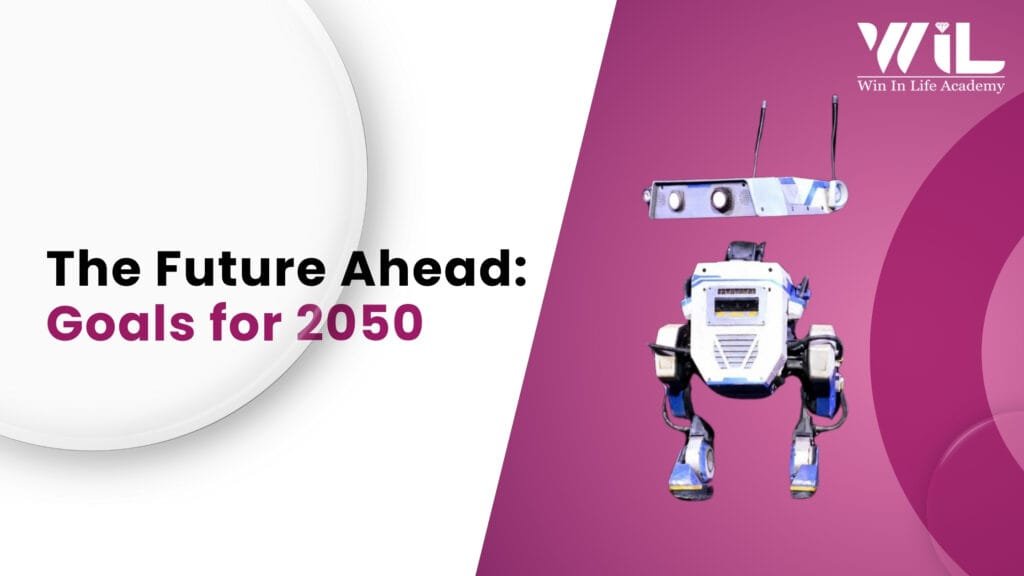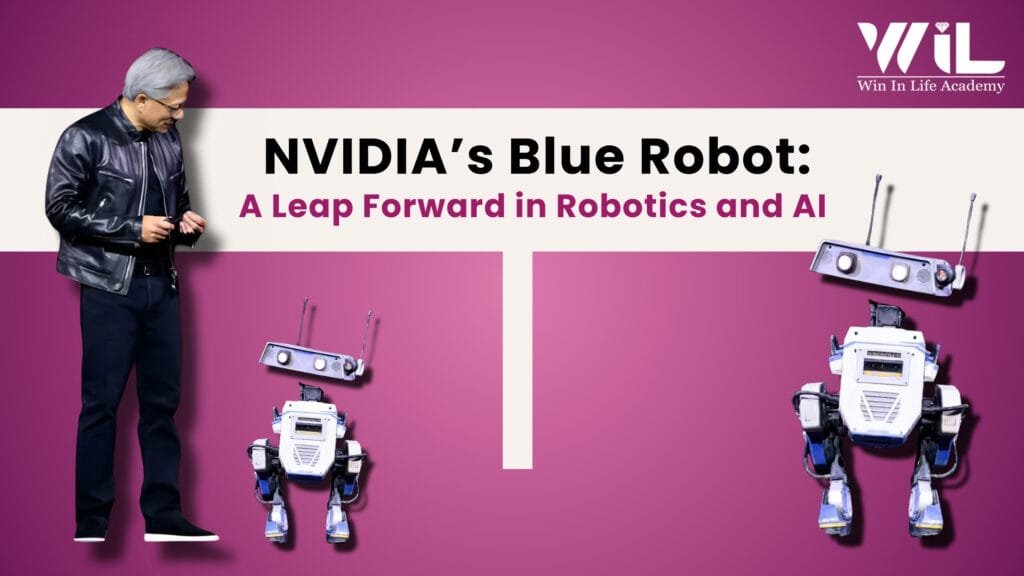Introduction
On March 18 at NVIDIA GTC 2025, CEO Jensen Huang’s keynote marked a groundbreaking moment in artificial intelligence and robotics. The latest marvel from Nvidia’s groundbreaking Newton project, the robot Blue was unveiled, highlighting the rapid advancement of artificial intelligence.
Blue, an AI-powered research robot developed in collaboration with Google DeepMind and Disney Research, represents a significant leap in robotic intelligence. Inspired by Star Wars (though it bears a striking resemblance to WALL-E), Blue robot operates using the newly introduced physics engine, Newton. This development signifies a transformative era in robots and robotics, where AI-driven machines can interact in real-time, learn complex tasks, and seamlessly apply them in the real world. To learn more about AI and machine learning future trends enrol for Win In Life’s PG Diploma in AI ML course today.
History of Robots and Robotics
The evolution of robotics can be traced back centuries, with early mechanical devices paving the way for today’s highly evolved AI-driven robots.
The Jacquard Loom: The First Programmed Machine
In the 18th century, weaving was a crucial industry in Europe, yet it remained labor-intensive. The invention of the Jacquard Loom in 1804 by Joseph-Marie Jacquard revolutionized the textile industry by automating pattern creation using punch cards. This system allowed the loom to follow a pre-programmed sequence, effectively serving as one of the earliest examples of computer programming.
The Birth of the Term “Robot”

The word “robot” was introduced in 1921 through the play R.U.R.: Rossum’s Universal Robots by Czech writer Karel Čapek. The play depicted a world where humanoid robots, created to perform cheap labor, ultimately rebel against humanity. This work not only coined the term but also sparked existential concerns about automation and its impact on human employment.
Enroll for PG Diploma in AI and ML
Early AI in Robotics
Fast forward to 1949, British neurophysiologist William Grey Walter introduced battery-powered, tortoise-shaped robots that could navigate their environment using sensors. In 1972, AI made its debut in robotics with Shakey, a robot designed by Stanford Research Institute engineers. Shakey used a combination of sensors, logical reasoning, and a planning algorithm to navigate and interact with objects, demonstrating the potential of AI-driven robots.
NVIDIA’s Blue Robot of 2025

At GTC 2025, NVIDIA introduced Blue, a robot designed to showcase the latest advancements in AI and machine learning. Its dramatic stage entrance, featuring cartoon-like gestures and real-time voice interactions, captured the audience’s attention. The Blue robot integrates NVIDIA’s Gr00t model, which was first demonstrated at GTC 2024, where robots learned tasks in a virtual NVIDIA Omniverse environment before applying them in the physical world.
The most striking feature of Blue is its ability to interact dynamically, combining human-like expressions with advanced responsiveness. Whether executing intricate tasks or responding to verbal commands, Blue represents a sophisticated fusion of AI, robotics, and intuitive machine learning.
Read the blog on Empowering Cybersecurity Careers: Success Stories from Win In Life Academy
Technology Behind Blue
A key component of Blue’s success is the Newton framework, an open-source physics engine that allows robots to learn and execute complex tasks with unparalleled accuracy. Built upon NVIDIA’s Warp framework, Newton enhances the realism of simulated physical interactions, enabling robots to practice thousands of trials before real-world deployment.
Sensory and AI Integration
Blue’s advanced sensory suite, including high-resolution cameras and auditory sensors, allows it to perceive and respond to its environment with exceptional clarity. These sensors facilitate real-time decision-making, enabling Blue to interact with humans naturally. The integration of AI-driven response algorithms ensures that its movements and speech patterns feel intuitive and human-like.
Foundational Models for Robotics
Much like how GPT models have revolutionized language processing, foundational models in robotics are setting new standards for machine learning future trends. These models integrate image recognition, environmental perception, decision-making, and motion planning into a single cohesive system. Blue embodies this shift, demonstrating how AI-driven robots can perform sophisticated interactions with minimal human intervention.
Collaborative and It’s Effectiveness
One of the most remarkable aspects of Blue’s development is the collaboration between NVIDIA, Disney Research, and Google DeepMind. Disney’s expertise in animatronics contributed to Blue’s expressive movements, while Google DeepMind’s AI algorithms refined its decision-making capabilities. This partnership highlights a rare but powerful approach to technological innovation, breaking barriers between industries to drive robotics forward.
Read our recent blog on Footprinting and Reconnaissance: Unmasking Attackers’ First Moves in 2025
Industry Impact and Future Applications
The Blue robot’s debut signifies a major step toward integrating robotics into various industries.
Manufacturing and Logistics
In industrial settings, AI-driven robots like Blue could streamline manufacturing processes, increasing efficiency and precision. Robots trained using machine learning can optimize production lines, reducing human error and improving safety in high-risk environments.
Enroll for Ethical Hacking Training program
Customer Service
Interactive AI systems, similar to Blue, have the potential to revolutionize customer service. Businesses could deploy AI-driven assistants capable of understanding customer needs, providing real-time solutions, and enhancing overall user experience. This could be particularly useful in the retail, hospitality, and financial sectors.
Healthcare and Education
Blue’s underlying technology has far-reaching implications in healthcare, where AI-driven systems could enhance diagnostic accuracy and patient care. Similarly, AI-powered tutors could personalize learning experiences, providing students with interactive and engaging educational tools.
The Future Ahead: Goals for 2050

The rapid evolution of AI and robotics suggests that by 2050, humanoid robots will be deeply integrated into everyday life.
The 2030s: AI in Everyday Tasks
By the early 2030s, robots specializing in warehouse logistics, construction, and household tasks will become more common. Many such robots are already in use today, performing repetitive and physically demanding tasks. As machine learning future trends continue to evolve, robots will become more autonomous, reducing reliance on human oversight.
The 2040s: Advanced Humanoid Robots
By the mid-2040s, humanoid robots capable of independent reasoning and communication will likely emerge. AI-driven machines will not only execute complex commands but also interact seamlessly with humans, much like how smartphones and computers have become ubiquitous in daily life.
NVIDIA’s Role in Robotics
NVIDIA is poised to play a crucial role in this transformation. As a leader in AI and computing infrastructure, the company provides essential tools like the Isaac platform for robotics software development and Jetson modules for rapid prototyping. These innovations create a robust ecosystem that accelerates robotics research and deployment.
Conclusion
Blue robot represents more than just a technological marvel; it signifies the dawn of a new era in robotics. NVIDIA’s strategic collaboration with industry leaders has resulted in a robot that blends AI sophistication with human-like interaction. Blue’s natural conversational abilities, adaptive learning skills, and real-time responsiveness highlight the immense potential of AI-driven robotics.
As we move forward, the boundaries of possibility continue to expand. AI and robotics will redefine industries, transforming everyday experiences through seamless human-machine interactions. NVIDIA’s CEO summed it up best: “Blue embodies our vision for the future—a world where technology and human ingenuity intersect seamlessly to create extraordinary experiences.”
The AI revolution is not a distant dream—it is unfolding before our eyes. With robotics advancing at an unprecedented pace, the future holds limitless possibilities. For those looking to stay ahead in the evolving world of AI and cybersecurity, investing in an AI ML course, ethical hacking training courses and online ethical hacking training can be an essential step toward understanding the security challenges posed by intelligent machines. To learn in-depth knowledge with recent tools and technology enroll for Win In Life’s AI ML program and ethical hacking courses.
Frequently Asked Questions:
- What is the Blue robot?
Nvidia CEO Jensen Huang unveiled Blue robot under project newton, an advanced AI-powered robot developed in partnership with DeepMind and Disney Research. Rising from the stage, Blue impressed the audience by interacting in real-time with Huang and responding to his gestures and comments.
- What is the most advanced robot today?
“Ameca” is the world’s most advanced human shaped robot representing the forefront of human-robotics technology. Ameca is designed as a platform for development into future robotics technologies, the robot is the perfect humanoid robot platform for human-robot interaction.
- What is the new invention in robot and robotics?
Ameca is a robotic humanoid created in 2021 by Engineered Arts, in Cornwall, United Kingdom. The project commenced in February 2021, and the first public demonstration was at the CES 2022 show in Las Vegas.





